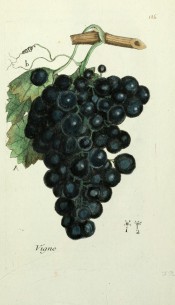Vitis vinifera L.
Climbing or scrambling deciduous shrub, leaves palmately-lobed, orbicular, the flowers insignificant, pale green, in dense panicles, followed by edible green to nearly black, globular or ovoid fruits. Individual stems to 35m. [RHSD, Hortus].
Horticultural & Botanical History
‘The cultivation of the vine dates back to ancient times; it is thought to have spread from Anatolia to Syria and then to Palestine by 5000 BC or even earlier. Vine growing is indicated by grape seeds found in Early Bronze Age sites at Jericho and Lachish. As with so many hardy fruits, the grape was then introduced west and north and also to Egypt, and the fruit figures prominently in Greek and Roman literature, as well as in the Bible.
By the 5th century BC Italian vineyards were exporting very large amounts of wine. During the same period the vine was established in southern Spain and the south of France, and later in North Africa which, by the 3rd century, began to supplant the Italian trade. The spread of viticulture northwards continued under Roman influence. By AD 600 all climatically favourable areas of France – first the southwest centred on Bordeaux, then through central and eastern France to the German border – saw viticulture firmly established; within the next two centuries it reached Germany and southern Britain. The vine’s slow progress northwards can probably be explained by Rome’s rigid legislation that restricted planting to cereals and other essential foodstuffs. […]
As Spain colonized vast areas of South America, so the vine was soon introduced there too. In North America, early efforts in the eastern states foundered on the ravages of Phylloxera vastatrix, an aphid that attacks the grape vine. This pest was not present in California, however, and vineyards expanded and flourished there. The vigorous California grape vines became the rootstocks on to which phylloxera-susceptible European vines were grafted in the late 19th century [also in Australia], thereby saving the great European vineyards from extinction. At about the same time, European vines were cross-pollinated with American cultivars, thereby producing phylloxera-resistant hybrids. These are widely grown today, though some believe the grapes are of lesser quality than their European ancestors.
The grape grown since pre-Biblical times in Europe and Asia is derived from Vitis vinifera, the European wild grape (Probably subspecies sylvestris), and its cultivars still account for much of the present-day grape production. Classical writers such as Theophrastus, Cato and Pliny assessed the virtues of the many cultivars of their times and countless more have been selected since then.’ [RHSD/1999].
Vitis Vinifera is figured in the Flora Parisiensis [Flora Parisiensis vol.2, pl.126/1777]. This is the figure used here.
History at Camden Park
55 grape varieties are described in the Hortus, all varieties listed in the catalogues. 13 of these are table grapes, 7 grapes used both for table and wine, and 35 wine grape varieties. Most of these are described in William Macarthur’s own words, taken from his publication Letters on the Culture of the Vine, Fermentation, and the Management of Wine in the Cellar. This was published in 1844 under the pen name Maro.
Notes
Published Jun 23, 2010 - 10:54 AM | Last updated Jun 23, 2010 - 11:12 AM
| Family | Vitaceae |
|---|---|
| Category | |
| Region of origin | South east Europe to the Caucasus and Turkestan |
| Synonyms |
|
| Common Name | European Vine, Wine Grape, European Grape Vine, Common Grape Vine |
| Name in the Camden Park Record | Grape Vine |
| Confidence level | high |


